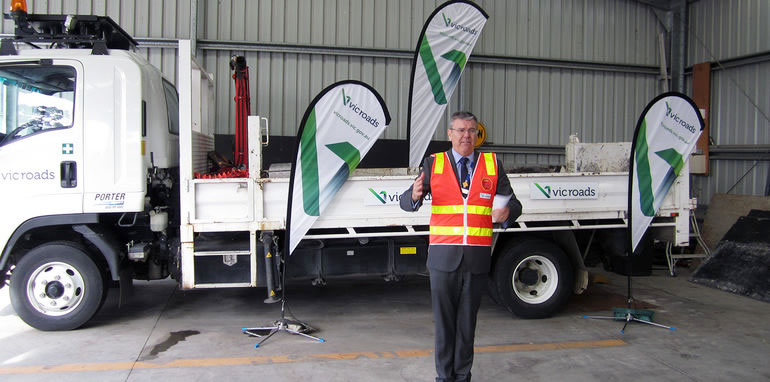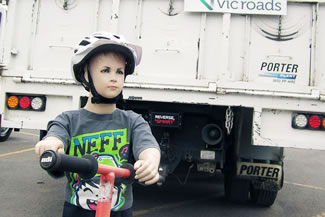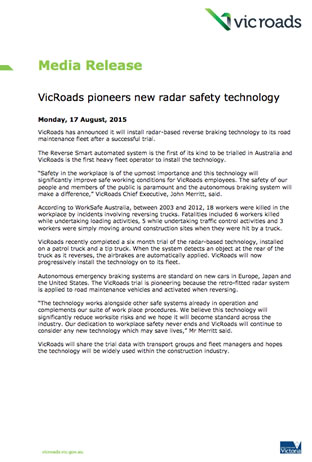Media Library
Reverse Smart in the mediaNew radar safety technology
By Safety Solutions Staff
VicRoads announced it will install radar-based reverse braking technology on its road maintenance fleet, which could become standard across industry.
VicRoads said the automated system is the first of its kind to be trialled in Australia and it is the first heavy fleet operator to install the technology.
“Safety in the workplace is of the upmost importance and this technology will significantly improve safe working conditions for VicRoads employees,” said VicRoads Chief Executive John Merritt.
“The safety of our people and members of the public is paramount and the autonomous braking system will make a difference.”
According to WorkSafe Australia, between 2003 and 2012, 18 workers were killed in the workplace by incidents involving reversing trucks. Fatalities included six workers killed while undertaking loading activities, five while undertaking traffic control activities and three other workers who were hit by a truck while moving about on construction sites.
VicRoads recently completed a six-month trial of the radar-based technology, installed on a patrol truck and a tip truck. When the system detects an object at the rear of the truck as it reverses, the airbrakes are automatically applied.
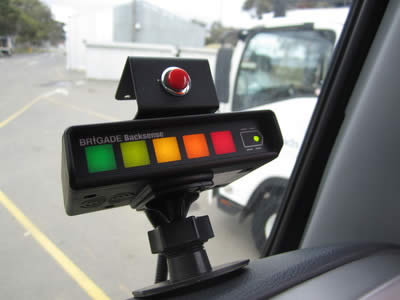
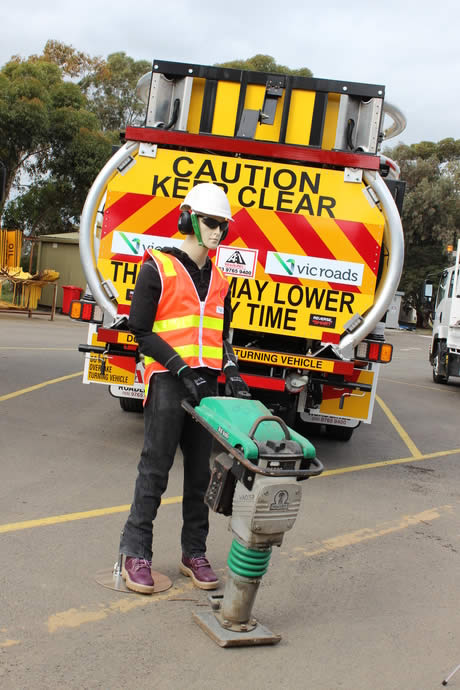
“The technology works alongside other safe systems already in operation and complements our suite of workplace procedures,” said Merritt.
Autonomous emergency braking systems are standard on new cars in Europe, Japan and the United States; however, the VicRoads trial is considered to be pioneering due to the retrofitted radar system applied to road maintenance vehicles that is activated when reversing.
“We believe this technology will significantly reduce worksite risks and we hope it will become standard across the industry,” said Merritt.
“Our dedication to workplace safety never ends and VicRoads will continue to consider any new technology which may save lives.”
VicRoads will share the trial data with transport groups and fleet managers and anticipates the technology will be widely used within the construction industry.
VicRoads adding reverse auto-braking tech to roadworks fleet
by Mike Stevens from Car Advice
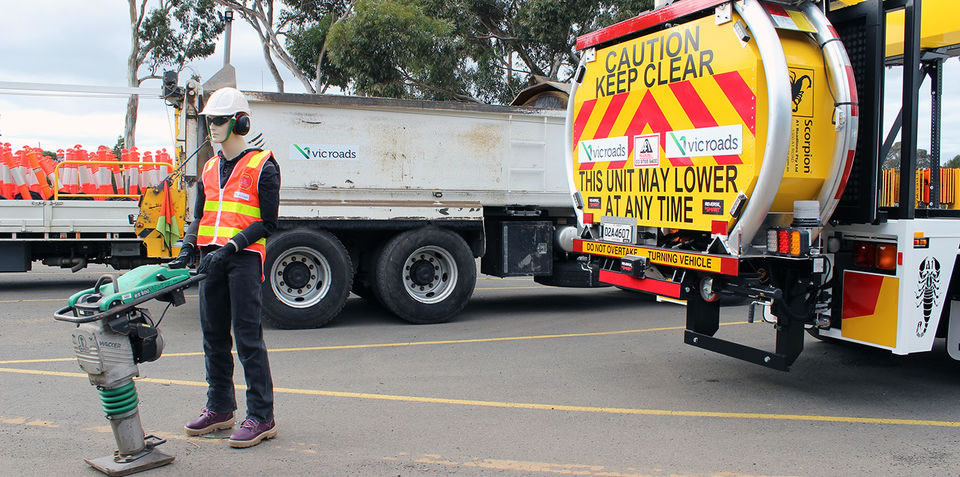
The addition of the radar-based system follows the completion of a successful six-month trial, which VicRoads says is the first of its kind in Australia.
The system, tested with and supplied by Victorian company Reverse Smart, is used to automatically detect an object at the rear of a vehicle while reversing and immediately apply the brakes.
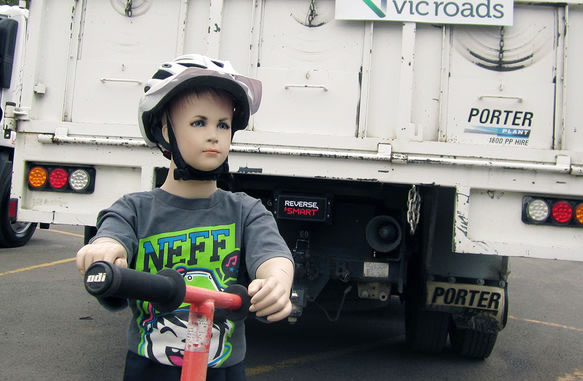
“Safety in the workplace is of the utmost importance and this technology will significantly improve safe working conditions for VicRoads employees. The safety of our people and members of the public is paramount and the autonomous braking system will make a difference,” VicRoads CEO, John Merritt, said.
The technology will initially be installed on 38 existing heavy vehicles on the VicRoads road maintenance fleet, with more to be added in the future.
Importantly, VicRoads will share the data of its trial with private companies across the maintenance and construction industries to grow awareness of the technology’s capabilities.
“We believe this technology will significantly reduce worksite risks and we hope it will become standard across the industry. Our dedication to workplace safety never ends and VicRoads will continue to consider any new technology which may save lives,” Merritt said.
Data supplied by WorkSafe Australia shows that between 2003 and 2012, 18 workers were killed in workplace incidents involving reversing trucks.
In the passenger vehicle world, the local arm of global technology company Bosch has recently previewed a system called Back Over Avoidance, which works in a similar way to detect obstacles – such as a child in the driveway – and automatically apply the brakes.
VicRoads reverses to the future
Radar and autonomous braking will be retro-fitted to authority’s truck fleet
By IAN PORTER
VICTORIAN roads safety authority VicRoads has announced it will retro-fit radar-based automatic reverse braking systems to its road maintenance fleet in a bid to curb workplace death and injury.
The Victorian government authority has completed a six-month trial with two trucks and is now converting another initial batch of 38 trucks at a cost of about $5000 a vehicle.
It is planned to roll out the technology across the whole VicRoads fleet over time.
VicRoads chief executive John Merritt said safety was of the utmost importance and that the automatic reverse braking technology would significantly improve safe working conditions for its employees.
“The safety of our people and of the public is paramount and the autonomous braking system will make a difference,” he said after a demonstration of the technology this week.
Mr Merritt pointed to WorkSafe Australia figures revealing that 18 workers were killed in reversing accidents across Australia between 2003 and 2012.

Of those, six were killed while loading vehicles, five were engaged in traffic management and three were just moving around construction sites.
VicRoads points out that the system will also prove valuable in residential areas, where it is possible for a child or pedestrian to find themselves behind a reversing truck.
The six-month trial involved a patrol truck and a tip-truck, and the feedback from drivers was “very positive”, according to VicRoads.
The radar-based system comes from Reverse Smart in the United Kingdom and is fitted in Victoria by A1 Roadlines. It is suitable for any truck with air brakes.
VicRoads chose the radar-based system because the unit is not affected by rain, debris or grit like sonic systems are.
Radar systems work in all conditions, while reversing cameras are limited in dusk and the dark.
“The technology works alongside other safety systems already in operation and complements our suite of workplace procedures,” Mr Merritt said.
“We believe this technology will significantly reduce worksite risks and we hope it will become standard across the industry.
“Our dedication to workplace safety never ends and VicRoads will continue to consider any new technology which may save lives.”
The decision fits within a safety first pattern that has been established by the Victorian government over the years. Victoria was the first state to mandate the fitting of seatbelts and, more recently, was the first to mandate the fitting of electronic stability control systems.
It also reflects Mr Merritt’s previous roles. He started with VicRoads on May after four years as chief executive of the Environment Protection Authority.
Before that was executive director of WorkSafe and chief executive of the National Safety Council.

Published online in Go Auto on 19th August 2105
VicRoads Media Release
VicRoads pioneers new radar safety technology
17th August, 2015
The Reverse Smart automated system is the first of its kind to be trialled in Australia and VicRoads is the first heavy fleet operator to install the technology.
“Safety in the workplace is of the upmost importance and this technology will significantly improve safe working conditions for VicRoads employees. The safety of our people and members of the public is paramount and the autonomous braking system will make a difference,” VicRoads Chief Executive, John Merritt, said.
According to WorkSafe Australia, between 2003 and 2012, 18 workers were killed in the workplace by incidents involving reversing trucks. Fatalities included 6 workers killed while undertaking loading activities, 5 while undertaking traffic control activities and 3 workers were simply moving around construction sites when they were hit by a truck.
VicRoads recently completed a six month trial of the radar-based technology, installed on a patrol truck and a tip truck. When the system detects an object at the rear of the truck as it reverses, the airbrakes are automatically applied. VicRoads will now progressively install the technology on to its fleet.
Autonomous emergency braking systems are standard on new cars in Europe, Japan and the United States. The VicRoads trial is pioneering because the retro-fitted radar system is applied to road maintenance vehicles and activated when reversing.
“The technology works alongside other safe systems already in operation and complements our suite of work place procedures. We believe this technology will significantly reduce worksite risks and we hope it will become standard across the industry. Our dedication to workplace safety never ends and VicRoads will continue to consider any new technology which may save lives,” Mr Merritt said.
VicRoads will share the trial data with transport groups and fleet managers and hopes the technology will be widely used within the construction industry.
Rear Radar’s a Lifesaver
WORKING WHEELS
By JAMES STANFORD
SAFETY gear that stops trucks reversing into people is being rolled out in Victoria. The state road authority is leading by example and installing Reverse Smart – Radar-based reverse automated braking technology – on 38 VicRoads trucks, with more to follow next year.
Leading truck brands already have safety technology that enables a truck to stop automatically if it detects a vehicle, person or other object in front of the truck. However, there are no such factory fitments to stop the truck when it reversing. This is because trucks often have different bodies, most fitted after the truck’s delivery, or use trailers provided by a third-party supplier. According to WorkSafe Australia, there were 18 workplace deaths caused by reversing trucks between 2003 and 2012. VicRoads chief executive John Merritt, recounts his experience. “I worked for a construction business that did civil construction,” he says. “In 1997, one of our workers died after being struck by a reversing tip truck.” He says a lot has been done in recent years to protect workers around rolling equipment, or “plant”. There has been a lot of work in terms of separation, of using radios, of using reversing beepers and using reversing cameras. VicRoads has had incidents itself notwithstanding all those measures.”

VicRoads demonstrated Reverse Smart on a simulated roadwork zone. Rain had stopped but the road was wet. Business manager Davin Hamnett explains, “We have a dark, wet, cold day where system controls like cameras, beacons etc are very restricted in a wet zone, on a day like this cameras become pretty useless pretty quickly (due to grime that flicks onto the lens). “In operating conditions where hearing protection is being worn, reversing beepers are next to useless as well.” Here, the radar setup excels. In its digital application Reverse Smart works in a wider range of operating conditions than other automotive gear developed for low speed traffic accidents.
Reverse Smart can be fitted to just about any truck, old or new, as it works using the air brakes. A small box fitted to the rear of the truck or trailer activates only when reverse is engaged. Tuned to detect objects from about five metres, it kicks in when the the truck is within two to three metres of an object or worker, sounding an alarm and applying the brakes automatically. Green, yellow and red lights on an indicator also help to warn the driver of potential hazards. A “sleeper” button deactivates the radar briefly so the driver can reverse to hitch a trailer, for example.
Imported from Britain, Reverse Smart costs $5000 fitted. That might sound expensive, but as Merritt says: “You just can’t put a cost on a serious injury to a worker.”

